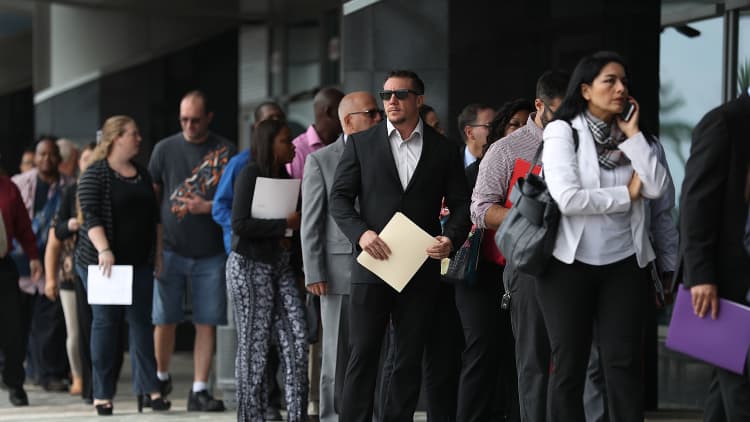
The number of Americans filing for unemployment benefits fell last week, pointing to a tightening labor market that likely keeps the Federal Reserve on course to announce plans next month to start reducing its massive bond portfolio.
Labor market strength was also underscored by another report on Thursday showing U.S.-based employers in July announced the fewest job cuts in eight months.
"The labor market remains tight as a drum even if it is not throwing off the sparks of higher wages and more inflation," said Chris Rupkey, chief economist at MUFG in New York. "The Fed can continue mopping up the stimulus provided to fight the financial crisis and recession."
Initial claims for state unemployment benefits decreased 5,000 to a seasonally adjusted 240,000 for the week ended July 29, the Labor Department said. Economists had forecast claims falling to 242,000.
Claims have now been below 300,000, a threshold associated with a healthy labor market, for 126 straight weeks. That is the longest such stretch since 1970, when the labor market was smaller. The labor market is near full employment, with the jobless rate at 4.4 percent.
Economists believe that labor market tightness will encourage the Fed to announce a plan to start offloading its $4.2 trillion portfolio of Treasury bonds and mortgage-backed securities in September.
The U.S. central bank is, however, expected to delay raising interest rates until December because of low inflation. The Fed has raised rates twice this year.
The U.S. dollar fell to a session low against the yen after Thursday's data while prices of U.S. government debt rose. U.S. stock index futures were trading marginally higher.
Layoffs decline
In a separate report on Thursday, global outplacement consultancy Challenger, Gray & Christmas said U.S.-based employers announced 28,307 job cuts last month, down 9 percent from June and the fewest number since November 2016.
Retailers planned to cut 3,862 jobs in July. They were closely followed by the health care products and services sector where employers planned 3,634 layoffs.
"While retailers are cutting the most jobs this year, those companies are also announcing the most hiring," said John Challenger, chief executive officer of Challenger, Gray & Christmas. "New retail jobs could be going to places like fulfillment and distribution centers."
Retailers have accounted for 245,616 of the 556,493 new jobs that have been announced so far this year, according to Challenger tracking. Online retail giant Amazon plans to hire about 50,000 workers this month at its warehouses and sorting centers.
Applications for unemployment benefits shot up at the beginning of the July, with economists blaming the jump on automakers who shut down assembly lines for annual retooling.
Some manufacturers like General Motors extended their summer shutdowns to manage excess inventory from declining sales, likely throwing off the model used by the government to strip out seasonal fluctuations from the data.
A Labor Department official said there were no special factors influencing the claims data and that no states had been estimated.
The four-week moving average of claims, considered a better measure of labor market trends as it irons out week-to-week volatility, fell 2,500 to 241,750 last week, the lowest level since May.
The claims data has no bearing on July's employment report, which is scheduled to be released on Friday, as it falls outside the survey period.
According to a Reuters survey of economists, nonfarm payrolls probably increased by 183,000 jobs last month after surging by 222,000 in June. The unemployment rate is seen falling one-tenth of a percentage point to 4.3 percent.
Thursday's claims report also showed the number of people still receiving benefits after an initial week of aid rose by 3,000 to 1.97 million in the week ended July 22. The so-called continuing claims have now been below the 2 million mark for 16 straight weeks, pointing to diminishing labor market slack.
The four-week moving average of continuing claims edged up 750 to 1.96 million, remaining below the 2 million mark for the 14th consecutive week.

